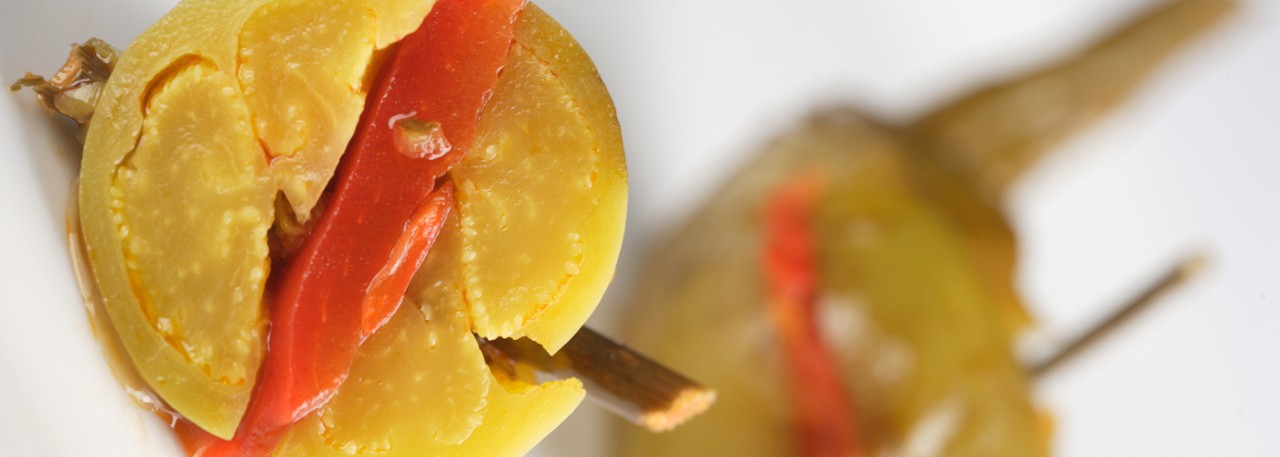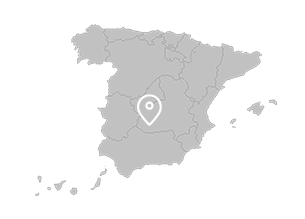.png.transform/rendition-xs/image_image%20(1).png)
Berenjena de Almagro PGI
Fruit of the species Solanum Melongena, sub-species Sculentum, Depressum type, from the production area and indigenous varieties admitted by the Regulatory Council.
Tasting notes
Pleasant aroma of fresh vegetables and spices, very intense, and with a good salt/vinegar balance. On the palate, the product has a characteristic taste of pimentón (a type of Spanish paprika) and vinegar, a result of its dressing. It has a smooth, non-leathery texture, and is not overly solid.
Other notes
With its typical golden color, at least 40% of the vegetable must be covered by the calyx, and it should be well formed, with a diameter of less than four and a half cm (1.8 in). The stalk, which is cut, should be no longer than the vegetable itself, and should support the eggplant well, with no thorns, blemishes or knocks. The dressing is pink or red in color, due to the pimentón it contains.
The fresh product is a fleshy berry, which can be varied in shape (round, elongated or pear-shaped), and its color can be green, purple, violet, with dark flecks, etc. The majority of the vegetable is covered by the calyx, which is pale green in color, and the exposed part should be violet.
Its approximate chemical composition is as follows:
- Proteins: from 1 to 2.5% Potassium: from 400 to 2,500 ppm.
- Vegetable fat: from 0.2 to 1.5% Fiber: from 0.01 to 0.04'/o.
- Carbohydrates: from 3 to 4.5% pH: less than 5
- Calcium: from 400 to 1,000 ppm.
Production / Processing method
A product of family-based agriculture, the areas sown are quite small, so that each farmer works less than one hectare (2.47 acres) of land. The eggplant is a plant which is easily exhausted, so the same plot should not be cultivated again until six or seven years have passed. In this respect, land around the cultivated area is often rented.
The seedbeds are sown approximately in February and, in May, the plants are transferred to the land where they are to be grown, which has previously been worked and fertilized with some 25,000 kg/ha (5,500 lbs/2.47 acres) of manure and approximately 600-700 kg/ha (1,320 - 1,540 lbs/2.47 acres) of high grade complex fertilizer. The most common plantation scheme is 50 cm (19.7 in) between plants, and 70 – 80 cm (27.6 - 31.5 in) between rows, meaning plant density of some 25,000 plants per hectare (2.47 acres).
Plowing takes place before planting, and is usually carried out twice, one deep plowing in winter (to cover the manure), and one 15 days before planting takes place, which is more superficial and serves to bury the mineral fertilizer and remove any weeds during cultivation.
Harvesting begins in July, with the vegetables being picked every three or four days. Alter each collection the area is irrigated and this process continues until November (approximately), when cultivation comes to an end with the drop in temperatures.
Once any defective or poor eggplants have been discarded, only fresh, tender products from registered plots will be used for preservation.
They are cooked for five to ten minutes, thus prohibiting the action of micro-organisms and conserving the product’s texture, without softening it. Once cooked, the eggplants are then fermented for between four and 15 days. This takes place in large containers, where the dressing is added (vinegar, vegetable oil, salt, cumin, garlic, paprika and water). Finally, the product is packed into cans or glass containers.
Geography / Relief and climate
The area corresponds to the region of Campo de Calatrava, located in the center of the province of Ciudad Real (Castile-La Mancha). It is characterized by a flat landscape, with small slopes or hills due to rocky concentrations which have resisted erosion, thus breaking with the uniformity of the surrounding area. The average altitude is 680 m (2,230 ft) above sea level, and the area is dotted with numerous mounds which reach as high as 900 m (2,952 ft).
The soils are limey and contain high percentages of clay, with an alluvial zone and in situ disintegration (red in color and with low organic material content), and another lower zone with accumulations of calcium carbonates, which is cemented in many cases. With their organic vegetable material, these soils make a valuable contribution to the production of the Almagro eggplant ecotype, the cultivation of which requires irrigation.
The climate of the area is extreme in nature, with enormous fluctuations, characteristic of the continental climate. It is characterized by very harsh winters and hot summers which, on occasion, reach 40º C (104 ºF). If the soil is sufficiently humid, the high temperatures allow it to produce high levels of vegetation, offering uniform, top quality fruit.
Average rainfall is 430 mm (16.9 in), and the rainy season is concentrated in the autumn, winter and spring, with long, dry summers.
The area is located between the Pellejero Creek to the north and the River Jabalón to the south, but has extremely low levels of surface water, meaning that almost all eggplant cultivation is irrigated with subsoil water.
Regulatory Council
Asociación para la Promoción de la IGP Berenjena de Almagro
Calle Ramón y Cajal 12, bajo
13260 Bolaños de Calatrava (Ciudad Real)
Tel: (+34) 926 871 565 / 618 614 811
igp@berenjenadealmagro.com
Sources:
- Spanish Ministry of Agriculture
The dressing is pink or red in color, due to the pimentón it contains.


- Berenjena de Almagro 1
- Berenjena de Almagro 2

Bolaños de Calatrava (Castile-La Mancha)
